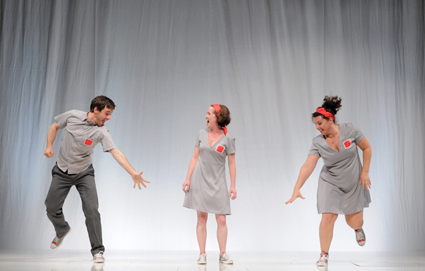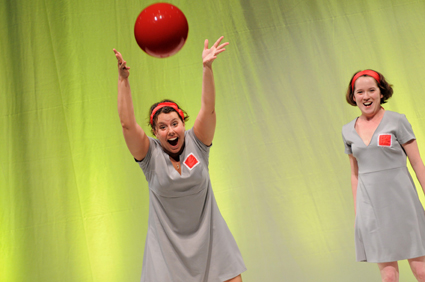A life re-lived and imagined anew
David Williams: Nature Theater of Oklahoma, Life and Times: Episodes 1-4

Life and Times: Episode 1, Nature Theater of Oklahoma, courtesy MIAF
The 10-hour marathon performance of Nature Theater of Oklahoma’s Life and Times: Episodes 1-4 begins with a casual introduction from co-directors Kelly Copper and Pavol Liska. “We are in the business of manipulating time and space,” Liska states, “We want you all to take responsibility for this going well.” Life and Times sets out to transform the entire life story of one person, company member Kristin Worrall, into theatre.
Over 16 hours of recorded phone conversations, Worrall meanders, in painstaking detail, from her earliest memory to age 34. The performance text is a verbatim transcript of these phone calls, preserving every verbal tic, hesitation and redundancy from the original source, every ‘like,’ ‘um’ and ‘ha ha.’ It’s an absurdly quixotic endeavour that could easily have become a stunningly banal vanity project. However, thanks to tight direction, playfully inventive staging and virtuosic performances from the ensemble (Ilan Bachrach, Asli Bulbul, Elisabeth Conner, Gabel Eiben, Daniel Gower, Anne Gridley, Robert M. Johanson, Matthew Korahais, Julie LaMendola, Kristin Worrall), Life and Times is an exhilarating and joyous experience.
In the absence of conventional dramatic content, co-directors Copper and Liska masterfully manipulate the subtle relationship between space, time and stage action. Every glance, gesture and choreographic sequence supports, underscores or cuts across the minor life incident being narrated. Performers move in odd formations while describing everyday experiences, and the punctuation of the original phone call (loops, pauses, self-interruptions) is ingeniously re-purposed to trigger formation changes, exits and re-entries, drink breaks and interval restarts. The performance text is also endearingly self-reflexive about its absurd immensity. Near the two-hour mark, the narrator exclaims: “God, this must be so boring for you. Sorry.”

Life and Times: Episode 1, Nature Theater of Oklahoma, courtesy MIAF
Episode 1 takes the form of a musical, beginning appropriately with a bright, folksy overture. The performers sing of memories of being bathed in a sink, of attending kindergarten, of making friends and of growing up in a yellow bedroom. When placed in the wrong reading group in early school, Worrall’s mother has to intervene so she can avoid becoming “a really dumb kid.” Social standing is clearly important from even a very young age, with the text charting petty jealousies about the size of other people’s houses, the kinds of clothes her friends wear and the cars various parents drive. Perhaps mirroring this concern with personal status within the social order, the physical grammar of Episode 1 might be best described as an ironic hipster appropriation of Communist-era mass choreography. The performers adopt and hold strange poses, sometimes aided by bright yellow gymnastic rings, but their facial expression seems consistently anxious, as if worried that despite making the correct gestures they still will not fit into the group.
The stage for Episode 2 is dark and shadowy, moodily lit with swirling stage smoke. Dressed in brightly coloured tracksuits, the performers re-enter with rock-star swagger. Our narrator has dark existential thoughts in the third grade, experiments innocently with sexual behaviours, inspired by daytime TV soap operas, and discovers sex through the medium of her father’s Playboy magazine collection. The emotions described in this stream-of-consciousness childhood remembrance are confused, awkward and ungainly. The treatment of the sung text is overblown, with the high-stakes rock chorus playfully at odds with the sheer ordinariness of the events narrated.
Episode 3 takes place on a manor house set, strikingly reminiscent of Agatha Christie’s The Mousetrap. The performers return costumed as characters in this unnamed detective drama, and the voice of the interviewer appears for the first time, embodied as the ‘detective.’ The acting turns melodramatic, the performers exchange arch looks and make dramatic pauses at unexpected moments, creating an hilarious mismatch between stage action and spoken text. This reaches its apotheosis in a ‘murder’ as the narrator describes her first period and being shocked by the blood. The episode ends with performer Anne Gridley crawling offstage after a frenzied self-questioning as to why this excessive storytelling exercise should continue.
Episode 4 is a tableau, with the cast all standing still onstage as if posing for a group photograph. After the high-energy musical theatrics of the past nine hours, time seems to move slowly during Episode 4. The text turns contemplative, discussing religion, doubt and belief, and the stillness lends the episode a soporific quality. Shortly before the end, the lighting turns green and shiny silver aliens inexplicably appear, silently joining the tableau. After this strange visual non sequitur, the lights suddenly fade to black and it’s all over. My 10-hour investment leaves me still hungry for more.
Melbourne International Arts Festival, Nature Theater of Oklahoma, Life and Times: Episodes 1-4, Playhouse, Arts Centre, Melbourne, 22-26 Oct
RealTime issue #118 Dec-Jan 2013 pg. 34






